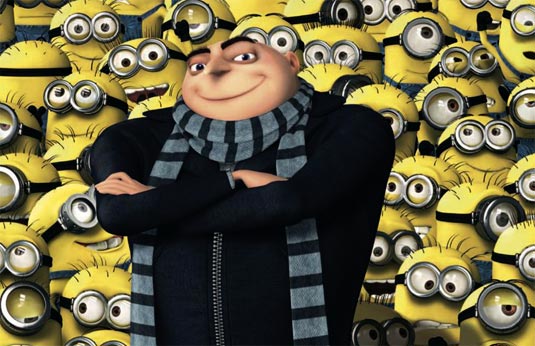Let’s talk about minions, that wonderful staple of archvillainy. Most exemplars of evil strive to command hordes of lesser baddies to do their dirty work for them. Minions act as an arch-villain’s eyes and ears, his/her mischievous hands and, when necessary, a living shield to cover a quick getaway.
My favorite minion scene ever. (Yes, I know they are technically, "henchmen".)
The mechanic behind minions in D&D 4e is one of the things I like about that particular edition. Minions are basically 1-hit bad guys that are only really encountered in the company of other, tougher antagonists. While they can dish out some damage to the heroes, they can also be mowed down like wheat, allowing the good guys to feel like a bunch of real badasses. The disposable minion mechanic helps mitigate the problems associated with mass combats in D&D. However, it can be taken further.
Mass melee with minions
When the heroes finally wind their way through an archvillain’s tangled, trap-filled lair, chances are, the boss baddie isn’t going to face them on his own. He’s gonna want backup in the form of as many minions as he can muster. If the heroes caught their arch alone, chances are, he would drop a smoke grenade, or a bag of bees and get out of Dodge, lickety split. Unfortunately, working sufficient backup into a battle is problematic.
First off, the baddie will ideally want to outnumber the heroes. In a typical D&D situation, this means at least 6 bad guys to a group of 5 heroes. The arch will likely want to tilt the scales even further, perhaps an order of 2 to 1 pushing things into the realm of a dozen bad guys staring down the heroes. By a strict reading of the D&D mechanics, such a situation will likely turn into an hours-long slog at the gaming table and-despite the exciting premise of a massive battle- will end up being no fun for anyone.
The biggest challenge to mass combat encounters, especially boss+minions is the sheer amount of dice rolling that has to take place. If a DM makes every individual roll for a big brawl between a party of 5 adventurers and a dozen bad guys, things get really boring reeeally fast! First, the GM will be rolling about twice as much as the players, and second, even if each character’s turn (declare an action, roll and move) is resolved in a minute or less, a round of combat (representing 6 seconds in game time) can take 15 minutes or more. That minute per turn mark becomes nearly impossible to hit when you factor in additional rolls like saving throws made in response to attacks, hunting for individual minion’s stats, etc.
Well, I have a couple tricks that I use to speed up these big brawls and keep the focus on the players.
1. Do hitpoints by the fives: I calculate minion hitpoints with tally marks, each representing 5hp. When one of my players lands an attack, I round to the nearest five and make the corresponding mark. This really speeds up my mental math when trying to calculate damage to a minion.
2. Forget the dice: Though I roll dice for unique actions taken by minions, if I am calculating saves for a whole posse caught in the PC pyromancer’s ubiquitous fireball, I instead rely on a pregenerated sheet of random D20 rolls. I use the WOTC online dice roller to generate a single roll of 1000 d20 and then copy and paste the breakdown into a Word doc. 12 minions caught in a blast? I simply calculate the minimum roll needed to save and then tick off the next 12 entries on the list. I do the same when a dozen minis go after the PCs with swords. tick off the attack rolls down the line. Speeds things up like you wouldn’t believe.
3. There is no I in Team: Have the minions work together as a group. Combine attacks into single actions like a unified volley of arrows. Turn avoidance into a single reflex save with the minion’s attack roll as the number to beat.
4. Minions + Minions cancel each other out: Sometimes, the PCs also bring friends to a fight, swelling the combat numbers to truly unwieldy proportions. In these circumstances, I simply narrate the flow of minion on minion violence. The groups of support characters become a sort of dynamic element to the setting, rather than fully realized participants. The focus is thrown to the players and their nemises while the battle swirls around them.
My particular game is full of massive minion encounters, and these shortcuts allow me to keep things exciting for the players while maintaining a feel of a full, frenetic fight.


You're a better man than I am, stranger in Cyberspace. How amazing to create moving monsters and minions. Blog on!
ReplyDeletehttp://francene-wordstitcher.blogspot.com